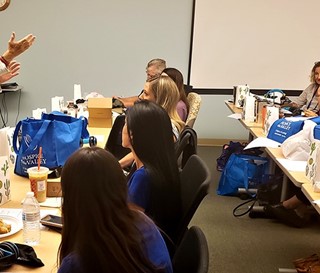Simulation shows what it’s like to have dementia

Hospice of the Valley Medical Director Gill Hamilton discusses the Dementia Moments experience with HOV care teams.
Arizona Republic
October 26, 2019
By Lin Sue Cooney
Imagine not remembering where you live. Forgetting your name. Not recognizing your own family members. That’s what it’s like to live with dementia.
It’s a heartbreaking disease that comes in many forms — Alzheimer’s disease being the most common. But in all its forms, it is incurable and progressive. It’s also deadly.
Dementia is now the fourth leading cause of death in Arizona. It’s becoming more prevalent as modern medicine helps us live longer. By 2025, the disease will affect 200,000 Arizonans and more than a half-million family members.
All of us will be touched by dementia.


Arcadia High School teacher Darcy Brodison struggles to complete tasks wearing gloves that simulate the difficulty some mid-stage Alzheimer’s patients have with dexterity.
Hospice of the Valley’s internationally recognized dementia team has created “Dementia Moments” — a virtual experience that can literally put any one of us in the shoes of a dementia patient. This unsettling realistic simulation challenges people to perform daily tasks as if they were living with moderate Alzheimer's.
Dr. Gill Hamilton, administrative medical director at Hospice of the Valley, first tried the simulation with care teams at the organization, so they could better understand what kind of world dementia patients are trying to navigate. “We want our staff to recognize that as symptoms progress, the world stops making sense. Instead of trying to get dementia patients to function the same way with less cognitive ability, we need to meet them where they are. It’s all about what they can still do… not what they have forgotten.”
Nurses, nursing assistants, doctors, social workers and chaplains began the exercise by putting on sunglasses that severely impair vision and headphones that blare static — making it impossible to hear or understand instructions to put on a belt, sort loose coins or sign a document. They even wear thick gloves that mimic the sensation of numb fingers — imagine buttoning a shirt with gardening gloves on!
It was almost comical to watch people fumble their way through the simulation. As their senses were diminished and their ability to focus was lost, they got a glimpse of the overwhelming obstacles that people living with dementia often encounter in daily life.
“We also want members of our community and healthcare professionals to appreciate the difficult demands of living with dementia,” said Jan Dougherty, who leads Hospice of the Valley’s Dementia Care Fellowship program. That program seeks innovative ways to improve the lives of dementia patients and their families.


Jan Dougherty, who leads Hospice of the Valley’s Dementia Care Fellowship Program, preparing Arcadia HS teacher Eric Bodznick for the virtual Dementia Moments experience.
Dougherty invites various community groups to give the virtual experience a try — and then watches as they struggle with even the most simple of tasks.
After the experience, participants shared their feelings.
“I was getting sick to my stomach,” said Michelle Bales, a Hospice of the Valley social worker. “It was torture for me. I was scared.” Those eight minutes felt like an eternity, she said. “I needed it to be over.”
Others reported feeling lost, anxious, helpless and even nauseous.
Eric Bodznick, a biotechnology teacher at Arcadia High School, was completely frustrated. “I couldn’t accomplish anything I wanted to. I had no dexterity to pick up the coins, I couldn’t button a shirt. I knew I should be able to do these things, but I couldn’t.”
Another teacher confessed that she would be afraid to get up in the morning if she had dementia. “This exercise showed me how different my world would be,” said Darcy Brodison. “And going through this would cause me to be fearful.”
“We want to mimic difficulty with interpreting language,” Dougherty said. As a dementia patient, “if you can’t hear, you can’t process,” which means you can’t perform or respond to commands. As caregivers, we “very quickly label people as having behavioral issues,” but the virtual experience allows us “to see things from a different vantage point.”
A student who volunteered to try the simulation said it was a real eye-opener. “It was an overwhelming feeling of not knowing what to do. For me, it was a few minutes, but for someone with dementia, this is their whole life.”
Dougherty also shared dementia-friendly communication skills so that all of us can better interact with someone living with dementia. Having patience, giving simple instructions, comforting with words and providing repetition can help dementia patients feel safe.
“Families often yell because they want their loved ones to accomplish a task that’s no longer possible,” Dougherty explained. “They think they’re pretending or not really trying — when really, they’re struggling and just can’t perform. Perhaps this experience can help us all empathize with what they’re really going through.”
For more about Hospice of the Valley’s Dementia Moments Simulation Experience or to learn how we support families through our Supportive Care for Dementia program, go to dementiacampus.org or call 602-530-6900.
Lin Sue Cooney is Hospice of the Valley's director of community engagement.
